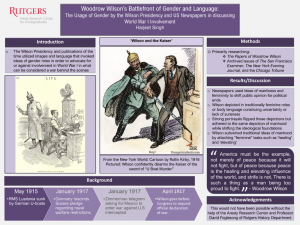Singh, Harjeet: Woodrow Wilson’s Battlefront of Gender and Language: The Usage of Gender by the Wilson Presidency and US Newspapers in discussing World War I Involvement
Title: Woodrow Wilson’s Battlefront of Gender and Language:
The Usage of Gender by the Wilson Presidency and US Newspapers in discussing World War I Involvement
Name: Harjeet Singh
Major: History and Economics
School affiliation: School of Arts and Sciences
Programs: Aresty – RA Program
Other contributors: David Foglesong, Ethan Bull
Abstract: History has often been examined from a limited and one-dimensional perspective which historians are now seeking to change. Historian Kristin Hoganson’s examination of the events of the Spanish-American and Philippine-American wars concludes that the concept of gender was invoked to push the US towards war. However, the idea of whether this was unique to the late 1800s, or whether gender was an important political tool to engage with the American public’s feelings on armed conflict in other periods of American history is left open.
In researching Woodrow Wilson’s presidency, in particular 1915-1917, it becomes quite evident that gender was again a tool used by jingoists, pacifists, and others for World War I. Analysis of Woodrow Wilson’s presidential correspondence, as well as archived issues of contemporaneous newspapers such as the Chicago Tribune, the San Francisco Examiner, and the New York Evening Journal make clear that while Wilson attempted to keep the United States out of World War I, he also embroiled himself in another war. This war utilized gender tropes, in words and imagery, and was fought for the minds of the American people through Wilson’s speeches, and the editorials and political cartoons of friendly newspapers, against those editors and newspapers that sought to push the public towards approving of involvement in World War I.
